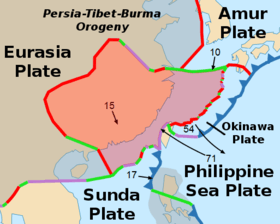Yangtze Plate
The Yangtze Plate, also called the South China Block or the South China Subplate, comprises the bulk of southern China. It is separated on the east from the Okinawa Plate by a rift that forms the Okinawa Trough which is a back-arc basin, on the south by the Sunda Plate and the Philippine Sea Plate, and on the north and west by the Eurasian Plate. The Longmenshan Fault on the latter border was the site of the 2008 Wenchuan earthquake.[1]
| Yangtze Plate | |
|---|---|
 | |
| Type | Minor |
| Movement1 | south-east |
| Speed1 | 15mm/year |
| Features | China |
| 1Relative to the African Plate | |
The Yangtze Plate was formed by the disaggregation of the Rodinia Supercontinent 750 million years ago, in the Neoproterozoic era. South China rifted away from the Gondwana supercontinent in the Silurian. During the formation of the great supercontinent Pangaea, South China was a smaller, separate continent located off the east coast of the supercontinent and drifting northward. In the Triassic the Yangtze Plate collided with the North China Plate, thereby connecting with Pangaea, and formed the Sichuan basin. In the Cenozoic the Yangtze Plate was influenced by the collision of the Indian and Eurasian plates creating the uplifting of the Longmen Mountains.[2] Its southward motion is accommodated along the Red River fault.
References
- "汶川8.0级地震成因分析 (Cause Analysis of the M8.0 Wenchuan earthquake)" (in Chinese). China Earthquake Administration. 2008-05-30. Retrieved 2008-09-07.
- JIA ChengZao, LI BenLiang, ZHANG XingYang & LI ChuanXin (November 2007). "Formation and evolution of the Chinese marine basins". Chinese Science Bulletin. 52: 1–11. doi:10.1007/s11434-007-6012-x.CS1 maint: multiple names: authors list (link)
Sources
- Bird, P (2003). "An updated digital model of plate boundaries". Geochemistry Geophysics Geosystems. 4 (3): 1027. doi:10.1029/2001GC000252.
